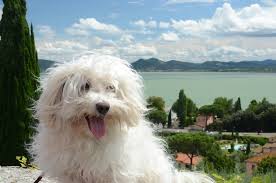If you’ve ever dreamt of having a soft, cuddly, and utterly charming little companion, the Bolognese might just be your dream dog. In this comprehensive guide, we’ll explore everything you need to know about this rare Italian breed—from its ancient roots to daily care and personality traits.
Bolognese Breed Origin and History
The Bolognese dog breed hails from Bologna, Italy, and dates back to Roman times. Nobles and aristocrats adored them for their affectionate nature and luxurious white coats. Often gifted among royals, Bolognese dogs were companions to the likes of Catherine the Great and Madame Pompadour.
Bolognese Dog Characteristics
- Size: Small (5.5–9 lbs)
- Height: 10–12 inches
- Coat: Long, white, fluffy, and hypoallergenic
- Lifespan: 12–14 years
These dogs are known for their calm demeanor, intelligence, and strong attachment to their humans.
Bolognese Temperament and Personality
The Bolognese is affectionate, curious, and easygoing. They thrive on companionship and don’t enjoy being left alone for long. Despite their regal history, they’re playful and adaptable to apartment life.
“My Bolognese, Luna, waits by the door every day at 5 PM to greet me with a tail wag and her favorite plush toy—it’s like she can read the clock!”
Bolognese vs Bichon Frise
Though they look similar, these breeds have distinct differences:
- Coat: Bolognese has a straight, cottony coat; Bichon has a curly one.
- Temperament: Bolognese is calmer and more reserved, while Bichons are extroverted and bouncy.
- Grooming Needs: Bolognese requires less trimming but more frequent detangling.
Bolognese Dog Appearance
With dark, expressive eyes and a soft, white coat that falls in loose ringlets, the Bolognese has an almost storybook charm. Their tails curl elegantly over their backs, and their compact frame is covered in plush fur from head to toe.
Bolognese Breed Standard
According to the FCI and AKC, key standards include:
- Head: Slightly domed with a short muzzle
- Eyes: Large, round, and dark
- Body: Square build with good muscle tone
Bolognese Dog Health Issues
While generally healthy, Bolognese dogs can be prone to:
- Patellar luxation
- Eye disorders (like cataracts)
- Dental issues due to small jaws
Regular vet checkups and proper care can help prevent most common Bolognese dog health issues.
Bolognese Dog Grooming Guide
Grooming is a commitment with this breed. Though they don’t shed, their long coat can mat easily.
- Brush daily with a slicker brush
- Bath every 2–3 weeks
- Use detangling spray or conditioner for easier brushing
- Trim nails and clean ears weekly
Bolognese Hypoallergenic Coat
Thanks to their non-shedding, cotton-like fur, Bolognese dogs are considered hypoallergenic—ideal for allergy-sensitive homes.
Bolognese Dental Care Tips
Dental care is vital:
- Brush their teeth 3–4 times a week
- Provide dental chews and toys
- Annual professional cleanings recommended
Bolognese Exercise Needs
They don’t require intense exercise, but they do need regular activity to stay healthy and happy.
- 2–3 short walks a day
- Indoor playtime or puzzle toys
- Light games like fetch or hide-and-seek
Bolognese Nutritional Needs
Feed your Bolognese a high-quality, small-breed dog food with balanced nutrients. Key tips:
- 2 meals per day (split evenly)
- Portion-controlled to avoid obesity
- Supplements like omega-3s for coat health
Final Thoughts
The Bolognese is a loyal, gentle, and intelligent breed perfect for those looking for a small dog with a big heart. With proper grooming, attention, and health care, they can be a joyfully fluffy companion for many years.
Frequently Asked Questions (FAQs)
What is the temperament of a Bolognese dog?
Is the Bolognese dog hypoallergenic?
How do I groom a Bolognese?
What are common health issues in Bolognese dogs?
What is the difference between a Bolognese and Bichon Frise?
How much exercise does a Bolognese need?

About SniffnTail
SniffnTail is your go-to destination for everything pets. From helpful advice, tips, and insights to thoughtfully selected products and resources, we’re here to support pet owners at every stage of their journey. Whether you're caring for a playful pup, a wise old cat, or anything in between, SniffnTail offers tools and knowledge to make pet parenting easier and more joyful.
Related Articles
 Dog Breeds • 6 min read
Dog Breeds • 6 min readBanned Dog Breeds in Russia: Everything You Need to Know Before Owning or Importing a Dog
Discover the list of banned dog breeds in Russia, import laws, and what pet parents need to know to stay on the right side of Russian regulations.
![Australia's Banned Dog Breeds (2025): Are You Affected? [Full List & Laws]](/_next/image?url=%2Fimages%2Faustralian-cattle.jpg&w=1920&q=75) Dog Breeds • 5 mins Read
Dog Breeds • 5 mins ReadAustralia's Banned Dog Breeds (2025): Are You Affected? [Full List & Laws]
Navigating Australian dog laws? Discover the specific breeds banned or restricted (Pit Bulls, Tosas, Dogo Argentino & more) and essential 2025 regulations for ownership & import. Stay compliant!
 Dog Breeds • 7 minutes
Dog Breeds • 7 minutesBorder Collie Dog Breed Guide: Traits, Care, and Living Tips
Discover the Border Collie breed’s temperament, training needs, grooming care, lifespan, and why they're perfect for active families. A must-read for dog lovers!

